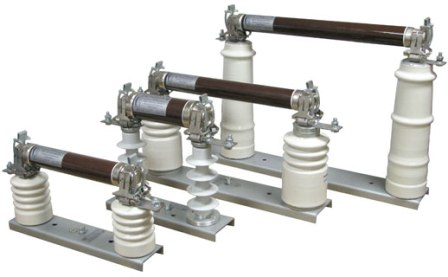Actions of electrical personnel in the event of blown transformer high voltage fuse
Burnout of the high-voltage fuse of the 6, 10, 35 kV voltage transformer: how to identify and eliminate this emergency
 Voltage transformers are an integral part of the distribution equipment of high-voltage substations. These elements are used to lower the high voltage to an acceptable (safe) value, which is fed to various protective devices, automation elements, measuring devices, as well as measuring devices for consumed electrical energy.
Voltage transformers are an integral part of the distribution equipment of high-voltage substations. These elements are used to lower the high voltage to an acceptable (safe) value, which is fed to various protective devices, automation elements, measuring devices, as well as measuring devices for consumed electrical energy.
For voltage protection, 6-35 kV transformers are used in the primary circuit high voltage fuses… Fuses protect voltage transformers from damage in the event of their operation in an abnormal mode — with a single-phase earth fault, when ferroresonance phenomena occur in the network, or in the event of a short circuit in the primary winding of the voltage transformer.
What can cause a blown fuse?
A blown high voltage fuse, which is installed at the inputs of the primary winding of the voltage transformer, leads to a distortion of the output (secondary) voltage readings, which in turn can cause the devices to which these circuits are connected to malfunction. voltage are connected.
For example, the undervoltage protection may not trip and therefore the de-energized busbar system will not be energized by the automatic transfer switch. Or, if it is a measuring device, then its complete or partial inoperability (large measurement error) is possible. It is also possible that the overcurrent protection with voltmeter blocking is not working properly, which can be triggered if consumers with large inrush currents are connected (there will be no voltage blocking).
Therefore, timely detection and replacement of a blown fuse is of paramount importance.

How do I know if a voltage transformer fuse is blown?
First, on the operation of protective devices. As a rule, in case of phase voltage imbalance, protective devices signal presence of ground fault.
In this case, it is necessary to determine the cause of this imbalance — the presence of a short to ground or false readings, which can be observed in the case of a blown high-voltage fuse of the voltage transformer, on which the phase voltage imbalance is recorded.
First, pay attention to the size of the readings. As a rule, in the presence of grounding in the network, the phase voltages change proportionally.If the reading for one phase is zero (full metal ground), then the voltages of the other two phases will rise to linear. If one phase shows a lower voltage (earth due to resistance), then the voltage of the other two will increase proportionally. When a ground fault occurs, the line voltage remains unchanged.
In the case of a blown high-voltage fuse, a slight imbalance of the phase voltages occurs. In this case, the readings of the two phases on which the fuses are in good condition, as a rule, remain unchanged, and the readings of the phase with a blown fuse decrease by a certain value. A slight deviation of the phase voltages of all phases is also possible, including when the fuses are in a continuous state.
Also, if the fuse blows, there is an unbalance in the line voltage. The voltage values between the lines vary between phases with a blown fuse and an integral fuse. For example, the fuse of phase «B» is blown. In addition to reducing the phase voltage in this phase, there will be a slight decrease in the line voltages between this phase and two healthy ones, that is «AB» and «BC». In this case, the voltage «SA» will remain unchanged.
Insulation monitoring kilovoltmeter readings can also vary depending on the size and load symmetry of outgoing user lines.
Very often, blown fuses due to a slight voltage imbalance are not detected by protective devices. This applies to protective devices of the electromechanical type (old model).Modern microprocessor-based equipment protection terminals can record any minor changes in electrical values.
Insulation monitoring kilovoltmeter readings can also vary depending on the size and load symmetry of outgoing user lines. This means that it is necessary to pay attention to the load symmetry of the outgoing user lines of the switchgear.
If in fact there is no grounding in the mains, the load is symmetrical, then it is necessary to make sure that the fuse of the voltage transformer is really blown. For this purpose, the section of the voltage transformer on which the phase voltage imbalance is recorded is fed from another section on which there are no voltage deviations. That is, the section switch turns on and the input switch turns off, energizing the section with a blown fuse.
If, after the electrical connection of the two sections, the phase imbalance is also recorded on the second voltage transformer, which initially, before connecting the other section, did not register deviations, then the reason lies in the presence of faults in the electrical network, and the fuse is working.
If the phase voltages of the second voltage transformer remain unchanged, accordingly, there are no disturbances in the electrical network and the reason for the presence of a phase imbalance of the first voltage transformer is a blown fuse.
It should be noted that the reason for the presence of deviations from normal values can also be the occurrence of ferroresonance phenomena in the electrical network.In this case, an increase of all phase voltages to linear can be observed. As a rule, when the capacitive or inductive component of the electrical network load changes, the voltage values are normalized (connection or disconnection of a power transformer, power lines).
Replacement of the damaged high voltage fuse of the 6, 10, 35 kV voltage transformer
To replace a blown fuse, it is first necessary to de-energize the voltage transformer and take measures to prevent accidental energization. If it is a 6 (10) kV switchgear voltage transformer, then to ensure safety when performing fuse replacement work, it is necessary to roll the voltage transformer trolley to the repair site.
If this cell type KSO, then to replace voltage fuses it is necessary to use insulating pliers in tandem with additional protective equipment that must be used in accordance with the rules for operating electrical installations (dielectric gloves, glasses, protective helmet, dielectric pad or insulating stand etc.)
To change fuses on a 35 kV voltage transformer, the voltage transformer must be disconnected from both sides. According to the primary scheme — by opening the disconnector, according to the secondary scheme — by turning off the breakers and removing the covers of the test blocks or removing the low-voltage fuses.
The main purpose is to create a visible gap on both sides of the voltage transformer to be repaired.Also, to prevent accidental voltage supply, it is necessary to earth the voltage transformer by including stationary earthing devices or installing portable protective earthing.
In all cases, for 6-35 kV voltage transformers, before removing them for repair, it is necessary to connect the voltage circuits of the devices to the voltage transformer of another bus system (section) that remains in service. Switching devices are usually provided for each of the devices to select the voltage circuit.
If, for one reason or another, the devices or measuring devices cannot be switched from another voltage transformer, they must be taken out of service, measures must be taken to correctly measure the consumed electrical energy (for measuring devices) immediately before the voltage transformer removed for repair.
When replacing blown fuses, it is necessary to check the integrity of the fuses of all phases, since several fuses can blow at the same time. It should also be noted that each type of fuse has its own resistance. As a rule, 6 (10) kV VT fuses have low resistance and their integrity can be checked by traditional dialing.
TN-35 kV fuses have a resistance of 140-160 Ohm and accordingly cannot be checked by regular dialing, their integrity is determined only by measuring the resistance and checking with the permissible values.This is why they very often mistakenly conclude that 35 kV fuses are defective because they do not ring in the traditional way to check integrity.
After replacing the fuse, the voltage transformer is put into operation. The transfer of voltage circuits to measuring devices and devices for relay protection and automation is carried out after checking the line and phase voltage of the voltage transformer put into operation. In the case of normalization of the readings, the voltage circuits are transferred, which in normal mode are powered by the VT put into operation.

